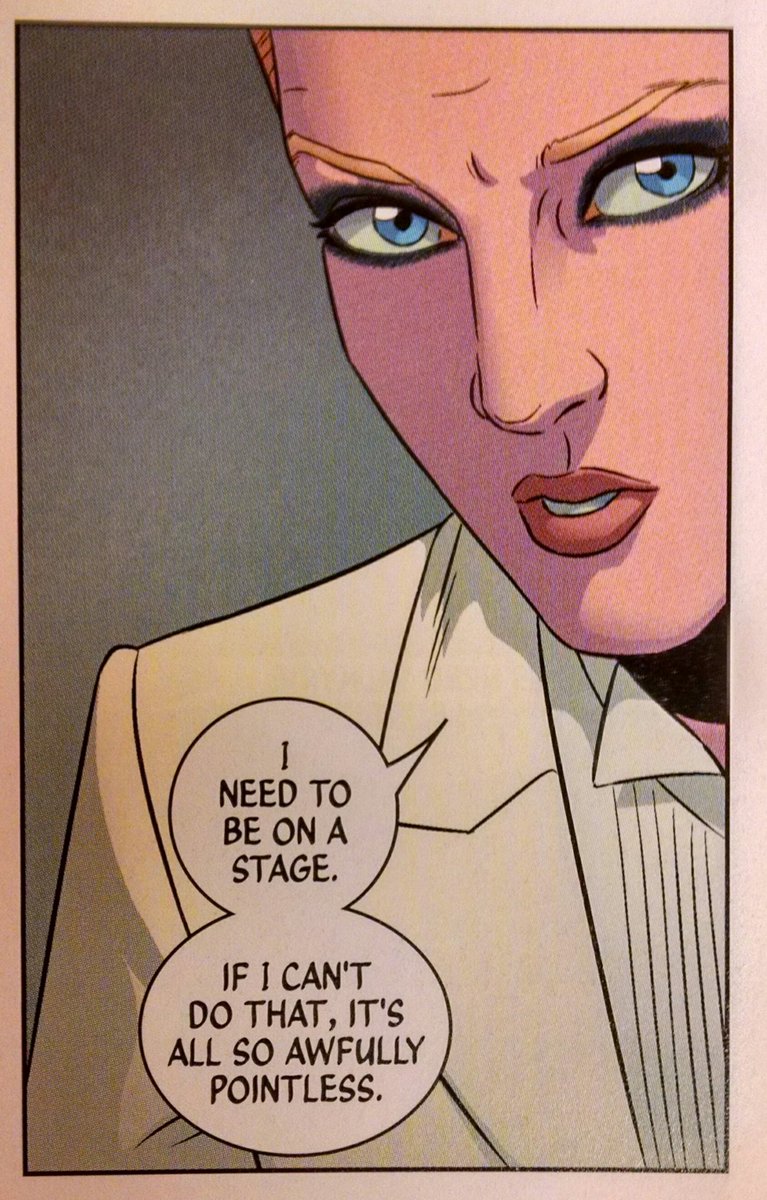The very first thing that comes up in The Wicked + The Divine‘s second issue is the name of Ananke. We saw her in the first issue via the prologue scene where the surviving members of the 1920s Pantheon executed each other at the close of their Recurrence presumably according to Ananke’s instructions. Ananke’s origins are largely mysterious, and we learn in this issue that she’s so secretive that before Laura overhears Lucifer ask Amaterasu to get Ananke in the courtroom no experts on the Recurrences had ever heard of her before.

Cover of The Wicked + The Divine #2. (Cover by Jamie McKelvie & Matt Wilson; Image credit: Comic Vine)
It’s this small bit of information that helps Laura connect with Cassandra. These two make an unlikely pair, with Laura’s fanaticism and Cassandra’s skepticism, but they complement each other with skills that are going to be necessary to unravel the mystery of the judge’s death at Lucifer’s hearing. Laura has an attitude that makes it easy for her to gain access to celebrities, and Cassandra has the expertise to help them figure out what leads they have available to them. Once the two would-be investigators join forces, all that’s left is for them to split up their workload, with Cassandra agreeing to try to get entrance to Valhalla, the Pantheon’s personal retreat built by Woden, and Laura going to seek out the Morrigan.
Those are the broad strokes of what happens to move the plot forward in this issue; it’s a relatively bare bones bit of story compared with all of the setup that took place in the first issue. We’re not directly introduced to any more new characters here besides a glimpse of Baal, the first of the Pantheon to debut, giving an interview about the incident in the courtroom. Other members are discussed in tantalizingly circumspect ways, like Lucifer’s noting that Woden has a cadre of Asian women whom he makes his Valkyries and Cassandra’s observation that nobody has any clue what deity Tara is supposed to be. We mostly just get bits and pieces of the larger world here; this is going to be a running motif for a while as Gillen and McKelvie set up a ton of questions that they don’t intend to start answering for a long while yet.

Lucifer explains that Ananke is the woman behind the curtain. (Artwork by Jamie McKelvie, colors by Matt Wilson, letters by Clayton Cowles)
In the meantime that we get these small bits about characters we haven’t met yet, there’s a ton of new information provided about Lucifer and Laura. Lucifer explains her own ascension as she gives Laura the skinny on Ananke’s role in the Recurrence. In a sequence we’re going to get very accustomed to seeing as the story progresses, we get a flashback of Lucifer in her predivine form as a typical teenager sneaking cigarettes while her parents are out of the house. Ananke appears to her, and then Lucifer falls into a pit of Ananke faces who explain the aspects of her divine identity and the role she’s expected to play. The popular conception of Lucifer is as a figure of rebellion against divine order and overweening hubris. At the same time that we read him in John Milton’s epic poem as the ultimate villain, we can’t help but find his confidence and ambition somehow admirable. The Lucifer of 2014 possesses those same traits, and it is undeniable that her reckless swagger is more than just a little captivating. The tragedy of her is that for all the trappings of rebellion that she wears, a little metatextual knowledge highlights just how much Lucifer is playing the part that she’s supposed to play within the Pantheon. She can’t help rebelling any more than Amaterasu can help shining like a giant burning ball of gas or Sakhmet can help acting like a creature of pure impulse and violence. The key difference is that Lucifer’s fundamental nature is to act against expectations, but in this incarnation she’s just not able to do that.

Laura isn’t so great at long-term planning. (Artwork by Jamie McKelvie, colors by Matt Wilson, letters by Clayton Cowles)
Laura’s character gains clarity in this issue as we learn a few more facts about her life. She’s the elder daughter of a very mild mannered couple who think that she’s been spending her time going to classes at university instead of chasing pop star deities. We also learn that Laura’s really serious about the whole “want to be a god who only lives for two years” thing. She’s decided to go all in on this particular plan, as part of the reason she’s been fine with blowing off her school is that she just doesn’t expect to have a future that lasts beyond 2016. It’s easy to read this as the shortsighted fantasies of a teenager, but I find Laura’s fascination with burning brightly and briefly to be an indicator of something deeper going on. So far in the first two issues, we’ve seen Laura, who’s been telling us directly about her experience through regular caption boxes, describe herself in primarily negative terms; she disdains her personal identity, notes only things that she thinks reflect poorly on her, and goes out of her way to draw attention to her lack of friends (either by deliberately omitting them from the narrative or simply not having any we can’t be sure). Laura exhibits a level of angst that I think we’re supposed to read as signs of depression. In that light, her entanglement in the intrigues of celebrity gods reads less like extreme fandom and more like an attempt to find something that she can cling to against the apathy that often characterizes severe depressive episodes. The pop star soap opera is highly melodramatic verging on the unreal, but it’s a stimulus that makes Laura feel something; it’s no wonder she wants to be a direct participant instead of just an onlooker.

This doesn’t get discussed as often as you’d think, but all the gods have a major craving for the adoration that comes from performance. (Artwork by Jamie McKelvie, colors by Matt Wilson, letters by Clayton Cowles)
The issue ends with the introduction of a new, previously unmentioned (not hard to do after two issues) god, Baphomet. There’s not much to say about him at this point, but he’s worth discussing next time after we get to see him in action.
Advertisements Share this:




